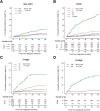The first competing risk survival nomogram in patients with papillary renal cell carcinoma
- PMID: 34088935
- PMCID: PMC8178392
- DOI: 10.1038/s41598-021-91217-z
The first competing risk survival nomogram in patients with papillary renal cell carcinoma
Abstract
There is still a lack of competing risk analysis of patients with papillary renal cell carcinoma (pRCC) following surgery. We performed the cumulative incidence function (CIF) to estimate the absolute risks of cancer-specific mortality (CSM) and other-cause mortality (OCM) of pRCC over time, and constructed a nomogram predicting the probability of 2-, 3- and 5-year CSM based on competing risk regression. A total of 5993 pRCC patients who underwent nephrectomy between 2010 and 2016 were identified from the Surveillance, Epidemiology, and End Results (SEER) database. The 2-, 3-, 5-year CSM rates were 3.2%, 4.4% and 6.5%, respectively, and that of OCM were 3.2%, 5.0% and 9.3%, respectively. The estimates of 5-year cumulative mortality were most pronounced among patients aged > 75 years in OCM (17.0%). On multivariable analyses, age, tumor grade, T stage, N stage, and with or without bone, liver and lung metastases were identified as independent predictors of CSM following surgery and were integrated to generate the nomogram. The nomogram achieved a satisfactory discrimination with the AUCt of 0.730 at 5-year, and the calibration curves presented impressive agreements. Taken together, age-related OCM is a significant portion of all-cause mortality in elderly patients and our nomogram can be used for decision-making and patient counselling.
Conflict of interest statement
The authors declare no competing interests.
Figures






Similar articles
-
A population-based competing-risks analysis of survival after nephrectomy for renal cell carcinoma.Urol Oncol. 2014 Jan;32(1):46.e1-7. doi: 10.1016/j.urolonc.2013.06.010. Epub 2013 Sep 17. Urol Oncol. 2014. PMID: 24054864
-
A novel nomogram and risk classification system predicting the overall survival of patients with papillary renal cell carcinoma after nephrectomy: A population-based study.Front Public Health. 2022 Oct 5;10:989566. doi: 10.3389/fpubh.2022.989566. eCollection 2022. Front Public Health. 2022. PMID: 36276376 Free PMC article. Clinical Trial.
-
A Competing-Risks Nomogram in Patients with Metastatic Pancreatic Duct Adenocarcinoma.Med Sci Monit. 2019 May 18;25:3683-3691. doi: 10.12659/MSM.913533. Med Sci Monit. 2019. PMID: 31102397 Free PMC article.
-
A non-cancer-related survival benefit is associated with partial nephrectomy.Eur Urol. 2012 Apr;61(4):725-31. doi: 10.1016/j.eururo.2011.11.047. Epub 2011 Dec 3. Eur Urol. 2012. PMID: 22172373
-
A population-based comparison of cancer-control rates between radical and partial nephrectomy for T1A renal cell carcinoma.Urology. 2010 Oct;76(4):883-8. doi: 10.1016/j.urology.2009.08.028. Urology. 2010. PMID: 20932408
Cited by
-
Development and Validation of a Nomogram to Predict Cancer-Specific Survival in Elderly Patients With Papillary Renal Cell Carcinoma.Front Public Health. 2022 Apr 4;10:874427. doi: 10.3389/fpubh.2022.874427. eCollection 2022. Front Public Health. 2022. PMID: 35444972 Free PMC article. Clinical Trial.
-
Are We Accurately Predicting Mortality in Renal Cancer? A Systematic Review of Prognostic Models.J Clin Med. 2025 Aug 19;14(16):5851. doi: 10.3390/jcm14165851. J Clin Med. 2025. PMID: 40869676 Free PMC article. Review.
-
Dephosphorylation-related signature predicts the prognosis of papillary renal cell carcinoma.Transl Cancer Res. 2024 Nov 30;13(11):5983-5994. doi: 10.21037/tcr-24-669. Epub 2024 Nov 25. Transl Cancer Res. 2024. PMID: 39697703 Free PMC article.
-
Predictive and Prognostic Assessment Models for Tumor Deposit in Colorectal Cancer Patients With No Distant Metastasis.Front Oncol. 2022 Feb 16;12:809277. doi: 10.3389/fonc.2022.809277. eCollection 2022. Front Oncol. 2022. PMID: 35251979 Free PMC article.
-
Case report: Uncommon gastric metastasis as a presentation of recurrent clear cell renal cell carcinoma.Front Oncol. 2024 May 2;14:1354127. doi: 10.3389/fonc.2024.1354127. eCollection 2024. Front Oncol. 2024. PMID: 38807761 Free PMC article.
References
MeSH terms
LinkOut - more resources
Full Text Sources
Medical

